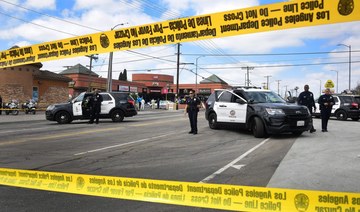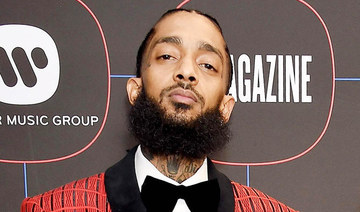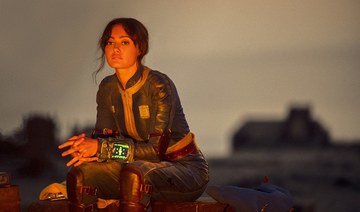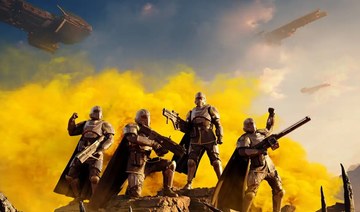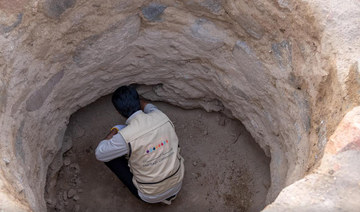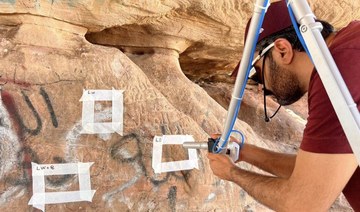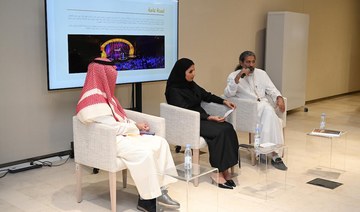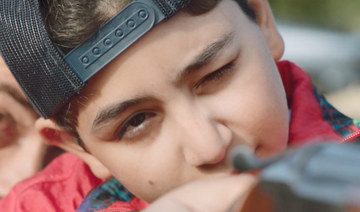LOS ANGELES: Nipsey Hussle’s legacy as a persistent rapper, community activist, uniter, a doting father, a protective sibling and a loving son were underscored at his public memorial service on Thursday, with deeply personal testimonies from those closest to the rapper, including his actress-fiancee Lauren London, collaborator and dear friend Snoop Dogg and his mother, who said she was at peace with the death of her “superhero” son.
Beyonce and Jay-Z were among the big-name celebrities who attended the three-hour event in Los Angeles at the Staples Center, where the last celebrity funeral held at the concert arena was Michael Jackson’s in 2009.
The arena was packed with more than 21,000 fans and drove home the important impact Hussle — just 33 when he died — had on his city and the rest of the world.
“I’m very proud of my son. My son Ermias Joseph Asghedom was a great man,” said Angelique Smith, dressed in all white. Standing onstage with Hussle’s father, Dawit Asghedom, she declared: “Ermias was a legacy.”
London, who was in dark sunglasses, was emotional but stood strong onstage as she told the audience: “I’ve never felt this type of pain before.”
London called Hussle “majestic” and “brilliant” and said she had learned so much from his presence. She added though she was hurting, she was really sad for their son Kross, whom she feared wouldn’t remember his dad: “My pain is for my two-year-old.”
Snoop Dogg’s words to immortalize his friend were both serious and silly, as he told old stories about Hussle and their brotherhood.
“This a tough one right here,” he said, visibly shaken but keeping his composure.
Snoop thanked Hussle’s parents multiple times and told his father that “you picked up another son in me.”
Hussle’s father said he knew his son was strong because when he was born, the umbilical cord was wrapped around his neck but he prevailed.
“He was a fighter,” he said.
Earlier in the ceremony, Hussle’s children also appeared onstage to pay tribute. London’s son with rapper Lil Wayne, Cameron Carter, said days after Hussle died, he had a dream he saw the rapper.
“I realized Ermias told me what heaven was like. He told me it was paradise,” Cameron said.
Cameron then told the audience that Hussle would look at him through the window at times and say “respect.” Cameron then asked the crowd to say “respect” in unison, and they complied.
Hussle was slain last month in front of a store that he tried to use to empower his South Los Angeles neighborhood. The public memorial service kicked off by paying respect to Hussle the rapper, as songs from his latest Grammy-nominated album, “Victory Lap,” filled the arena.
“Everybody put your hands in the air,” the DJ said as one of Hussle’s songs played. “It’s a celebration.”
Indeed, his mother danced in the aisle as R&B singer Marsha Ambrosius sang the Mariah Carey song “Fly Like a Bird” while fighting back tears. “This is for Nipsey y’all,” Ambrosius said before she started as she tried to gain her composure, sighing heavily.
But soon the focus was squarely on the person behind the persona. A montage of photos featuring the rapper from infancy, childhood and adulthood, with fellow rappers, his family and London, were shown to the crowd, set to Frank Sinatra’s “My Way.”
Stevie Wonder was the last performer to pay tribute to Hussle, who he said he had the chance to meet, saying: “We had a good conversation.” Before he sang “Rocket Song,” one of Hussle’s favorites, Wonder denounced gun violence and told the audience “there’s enough people being killed by guns and violence.”
Anthony Hamilton invoked the spirit of a church service when he performed in Hussle’s honor. Nation of Islam leader Louis Farrakhan hailed Hussle’s ability to bring different factions together. And blogger and media figure Karen Civil read a letter sent by former US President Barack Obama.
“I’ve never meet Nipsey, but I’ve heard his music through my daughters, and after his passing I had the chance to learn more about his transformation and his community work. While most folks look at the Crenshaw neighborhood where he grew up and only see gangs, bullets and despair, Nipsey saw potential. He saw hope. He saw a community that even through its flaws taught him to always keep going. He choice to invest in that community rather than to ignore it,” the Obama letter read. “He set an example for young people to follow and is a legacy worth of celebration. I hope his memory inspires more good work in Crenshaw and communities like it. Michelle and I send our sympathies to Lauren, Emani, Kross and his while family and to all those who love Nipsey.”
Father Thomas Uwal read a scripture in Tigrinya — the native language in Eritrea, the African country where Hussle’s father was from. Uwal spoke of Hussle being a “proud to be an Eritrean-American,” later saying to the late rapper’s family: “On behalf of all Eritreans ... we say our condolences to you.”
Books with an image of Hussle on the cover were handed out to service attendees. The book of nearly 100 pages contained numerous photos of Hussle with London, his children, and friends like Russell Westbrook and Snoop Dogg. It also had heartfelt messages from Rick Ross, The Game and LeBron James.
“I’ve never cried myself to sleep over any public figure before, but Nipsey’s presence meant so much for our community,” actress Issa Rae said in her message inside the book.
The hearse carrying Hussle’s coffin went through a 25-mile lap through the city, including past the property where Hussle had planned to turn an aging strip mall into new businesses and affordable homes. Finally, it will arrive at a funeral home in the city’s hard-scrabble Crenshaw district, where the rapper was born on Aug. 15, 1985.
Hussle was shot to death March 31 while standing outside The Marathon, his South Los Angeles clothing store, not far from where the rapper grew up.
Eric R. Holder Jr., who has been charged with killing Hussle, has pleaded not guilty. Police have said Holder and Hussle had several interactions the day of the shooting and have described it as being the result of a personal dispute.
For a decade, Hussle released much sought-after mixtapes that he sold out of the trunk of his car, helping him create a buzz and gain respect from rap purists and his peers. His said his stage name, a play on the 1960s and ‘70s rhyming standup comic Nipsey Russell, was given to him as a teen by an older friend because he was such a go-getter — always hustling.
Last year he hit new heights with “Victory Lap,” his critically acclaimed major-label debut album on Atlantic Records that made several critics’ best-of lists. The album debuted at No. 4 on Billboard’s 200 albums charts and earned him a Grammy nomination.
But the rapper was also a beloved figure for his philanthropic work that went well beyond the usual celebrity “giving back” ethos. Following his death, political and community leaders were as quick and effusive in their praise as his fellow hip-hop artists.
His family and friends vowed to continue his work, and London told the crowd: “The marathon continues!”
Nipsey Hussle, a hometown hero, immortalized at LA memorial
Nipsey Hussle, a hometown hero, immortalized at LA memorial
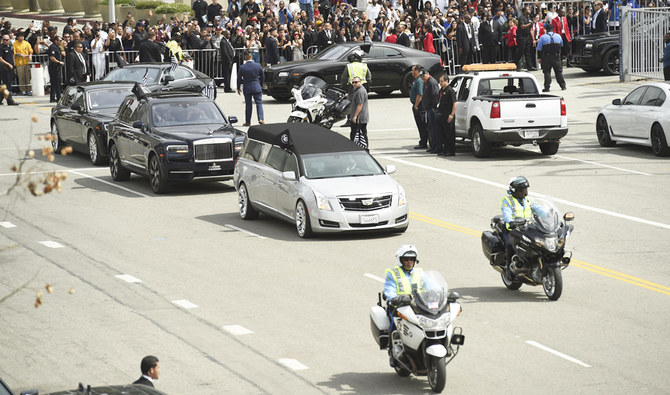
- Beyonce and Jay-Z were among the big-name celebrities who attended the three-hour event in Los Angeles
- And blogger and media figure Karen Civil read a letter sent by former US President Barack Obama
REVIEW: Netflix’s ‘Crashing Eid’

Shying away from the traditional, comedy television show “Crashing Eid” presents quite a progressive viewpoint — but certainly not an uncommon one.
The four-episode series follows the story of Razan, an independent young Saudi woman who fled her old life and built a new one in London along with her teenage daughter Lamar — only to find herself in love with a Pakistani Brit, Sameer.
The show opens with a surprise spin as Razan takes it upon herself to initiate a proposal to Sameer, who she has known for two years. She and her daughter then plan to take a short trip back to hometown Jeddah during Ramadan, without her family knowing that she has no plans to move back home — or that she is engaged.
Sameer decides to return the surprise by showing up to her family’s home, only to be met by Razan’s father, who mistakes him for a maintenance worker. This spurs the show into a flurry of misunderstandings and awkward interactions that surface some rather crucial unresolved family issues and traumas.
As Saudi has become more global in its population, in many ways including international marriages, the issues in “Crashing Eid” have become more vital to discuss than ever.
Rather than focusing on the difficulties that come with marrying a foreigner, such as lengthy legal procedures and official marriage approvals, the show hones in on societal acceptance. The aspects of honor and locality of marriage are brought to the surface.
The show also uses the main plot to dig up some underlying issues prevalent in any society, not just in Saudi Arabia. Through Razan’s homecoming, she is forced to revisit the reality of her previous marriage to Lamar’s father, who had been physically abusive. Choosing to leave him and start a new life abroad, she is met with societal condemnation and victim blaming.
While Razan’s brother Sofyan battles divorce and child custody issues, the family reveals the challenges of generational gaps. It also demonstrates the common shift to the globalization of younger generations and the tight hold on traditions within older ones.
The show has a unique way of making difficult or rather taboo topics palatable for a general Saudi audience. It sets the table for conversation, at the very least.
Sure, some of the acting seemed fairly novel, reminiscent of early 2000s sitcoms sans the laugh track, and the show also had a peculiar style of direction and editing.
But certainly, “Crashing Eid” must be applauded for its bold statements, proving that it is not afraid to rock the boat for the chance to tell authentic Saudi stories. For anyone looking to get a deeper sense into the modern-day Saudi household, the show is a must-watch.
Tunnel, fortification wall unearthed by archaeologists in Jeddah
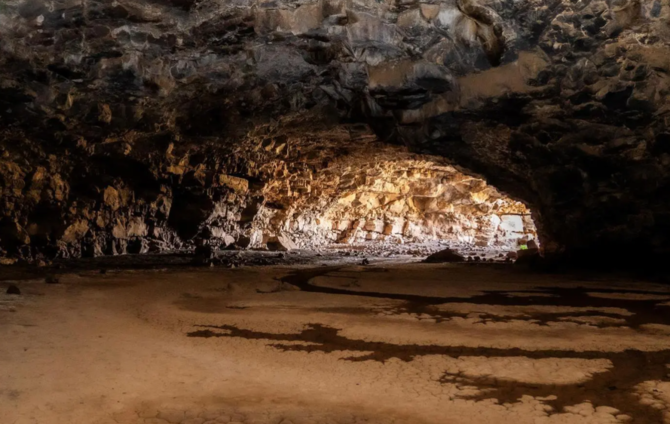
- Findings linked to expansion of city’s defenses in 18th and 19th centuries
- New evidence of human settlement discovered in Umm Jirsan cave in Madinah
RIYADH: A series of archaeological discoveries in Jeddah and Madinah were revealed on Thursday by the Historic Jeddah Program and the Saudi Heritage Commission.
The finding of new evidence of human settlement in Umm Jirsan Cave, located in Madinah’s Harrat Khaybar, was announced by the commission, and the remnants of an ancient underground tunnel and a fortified wall, which once encircled the city, were announced by the program as part of the inaugural phase of Jeddah’s Archaeology Project.
Situated in the northern sector of historic Jeddah, adjacent to Al-Kidwa Square and in close proximity to Al-Bayaa Square, these historical structures date back several centuries.
Some estimations put Jeddah becoming a fortified city during the late 10th to early 11th century, but laboratory analyses suggest that the new finds belong to a later phase of fortification, likely constructed during the 18th and 19th centuries.
Archaeological excavations revealed that by the mid-19th century, the tunnel had become unusable and was quickly filled with sand. However, the wall remained standing until 1947, and some parts of the tunnel’s supporting wall remained intact up to a height of three meters.
Imported European ceramics dating back to the 19th century were also found, highlighting the historic commercial connections of Jeddah. Additionally, a pottery fragment dating back to the 9th century was discovered in Al-Kidwa Square.
These findings are part of a broader collection of archaeological discoveries announced by the Historic Jeddah Program as outcomes of the first phase of its Archaeology Project — a collaborative effort that involves specialized national teams, Saudi experts from the Heritage Commission, and foreign archaeologists.
Their combined expertise has revealed a trove of 25,000 artifacts across four sites, marking a significant development in understanding the cultural evolution of historic Jeddah.
In Madinah, the Heritage Commission announced the discovery of new evidence of human settlement in Umm Jirsan Cave following research conducted by its archaeologists in cooperation with King Saud University, Germany’s Max Planck Institute and Saudi Arabia’s Geological Survey, as part of the Green Arabian Peninsula Project, which focuses on multidisciplinary field research.
It is the Kingdom’s first study that looks into archeological research inside caves, and involved archeological surveys and excavations in several parts of the cave, revealing evidence dating back to the Neolithic period.
The oldest piece of evidence dates back to between 7,000 to 10,000 years ago, encompassing the Copper and Bronze Age periods.
The study of the cave proved that it has been utilized by pastoral groups.
The artifacts discovered include wood, fabric, and some stone tools, in addition to rock art facades depicting scenes of grazing goats, sheep, cows and dogs, as well as hunting activities with different types of wild animals.
The commission noted that the scientific discoveries represent evidence of human settlement in the cave, and a great number of animal bones, including those of striped hyenas, camels, horses, deer, caribou, goats, cows, and wild and domestic donkeys were also identified.
The analysis of human skeletal remains using radioactive isotopes revealed that ancient humans relied on a predominantly carnivorous diet but that, over time, plants were introduced, suggesting the emergence of agriculture.
Saudi Cinema Encyclopedia prints first batch of film books
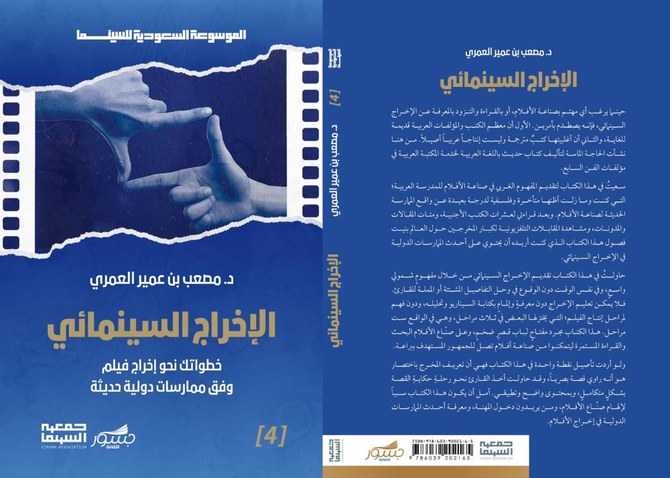
- Initial run of 22 titles part of plan to release 100 books by the end of the year
- First set of releases will be available to the public during the 10th Saudi Film Festival, held May 2-9 this year
RIYADH: The Saudi Cinema Encyclopedia, an initiative launched by the Saudi Cinema Association, will kick off with an initial release of its first 22 books, written by an international group of authors, as its first batch of publications.
The project aims to release 100 books in its first year, published by Josour Al-Thaqafah Publishing House.
The first set of releases will be available to the public during the 10th Saudi Film Festival, held May 2-9 this year.
The aim is to establish a periodic program for book production in Arabic to elevate the Kingdom’s film industry writing from amateur to an area known own for its professionalism and specialization.
Abdulwhab Aloryad, editorial director of the Saudi Cinema Encyclopedia and the bulletin of the Saudi Film Festival “Saafa,” told Arab News that the books were published to enhance knowledge among filmmakers.
“This encyclopedia aims to add to what the Saudi Film Festival has started and be an active contributor in Saudi cinema, reinforcing the beliefs of the festival organizers and their efforts to create a competitive film industry on a global level,” he said.
“The series will continue to be an icon in film knowledge, with its central goals of unveiling Saudi and Arab talent in authorship, presenting the latest new books in Arabic, and transferring specialized knowledge in this field from various other languages into Arabic to be available to those interested in the film industry.”
Aloryad said: “Since its launch in 2008, the Saudi Film Festival has believed in its authentic role in cultural and intellectual development aimed at professionals in the film industry. It has focused on the project of knowledge and has driven the wheel of authoring and translation in all fields related to the film industry in order to elevate all stages of the film industry.
“Based on this belief, the festival has adopted a periodic program for book production, presenting more than 50 books in its previous editions that shed light on various aspects of the film industry.”
REVIEW: Amazon Prime Video’s ‘Fallout’ takes gaming adaptations to next level
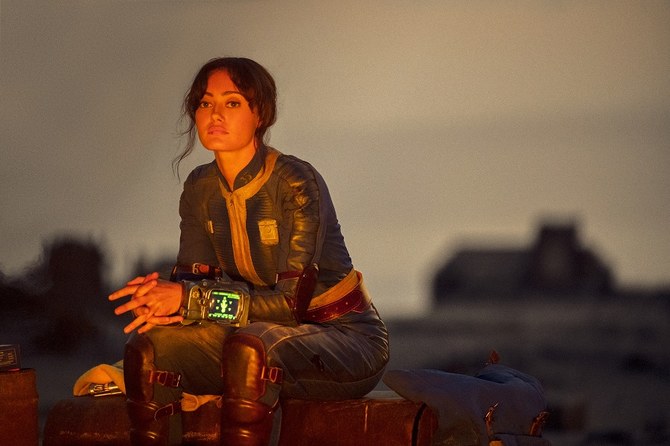
LONDON: Don’t say it too loud, but we might, finally, have reached the point when good TV adaptations of hit videogames become the norm, rather than the exception. Hot on the heels of “The Last of Us” and “The Witcher” comes “Fallout,” an eight-part series based on the post-apocalyptic world explored in the series of famed Bethesda games.
In an alternate future, with the world devastated by a global nuclear war, a community of wealthy individuals retreats to a series of underground vaults to ride out the fallout. Some 200 years later, wide-eyed vault dweller Lucy (Ella Purnell) is forced to leave the safety of her underground home when her father is kidnapped by raiders from the surface, kickstarting a journey that will not only make her confront the horrors of the unlawful society above, but also sees her meet a revolving door of eccentric (yet equally horrifying) characters along the way. Among these are Maximus (Aaron Moten), a squire in the militaristic Brotherhood of Steel, and The Ghoul (Walton Goggins), a terrifyingly mutated former actor now forging his way as a bounty hunter.
The key to the success of “Fallout” is that your enjoyment of the show is not dependent on whether or not the previous paragraph made any sense to you whatsoever. Rather, creators Graham Wagner and Geneva Robertson-Dworet, along with developers (and executive producers) Christopher Nolan and Lisa Joy have taken the wise decision to create a world wherein knowledge of the wider “Fallout” universe is a bonus, but not a prerequisite. So even if this is your first introduction to the world of Pip-Boys, gulpers and Vaulters, you won’t be penalized, and you certainly won’t feel like you’re missing out.
The world of “Fallout” is a gloriously gritty, bloody and savage one, but it’s also one of razor-sharp humor and fiendish satire — not least thanks to Goggins’ phenomenal turn as The Ghoul. Acerbic and frighteningly violent, The Ghoul is the very embodiment of the savage, unforgiving wasteland, and Goggins has a blast with perhaps the role of his career to date. Lucy is the polar opposite, and Purnell is equally as great as the naïve-yet-capable young woman entirely unprepared for the muck and murder she emerges into. Throw the two together with a razor-sharp, witty script and top-drawer production values and you have a show that’s about as much fun as you can have without a controller of your own.
Saudi poet and artist Hana Almilli: ‘After each piece, there’s some sort of conclusion’
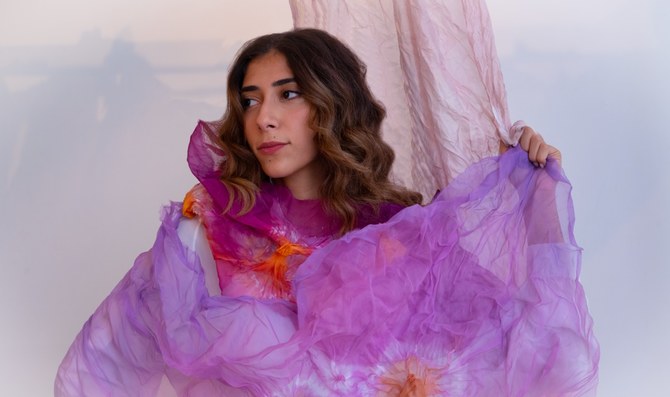
DUBAI: Saudi artist Hana Almilli and her two siblings grew up in a household where creativity and self-expression were actively encouraged. “My mom is a poet,” Almilli tells Arab News. “And my dad was very motivating in terms of doing photography.” Her two brothers, she adds, “are both talented in terms of music and art.” And with her Syrian maternal grandmother, Almilli shares a love of nature and of textiles.
But aside from being one of the main inspirations behind her creative output, Almilli’s family are also the subject of most of it. Through her poetry, embroidery, weaving, dyeing and photography, she explores her own history and her diverse cultural identity (she has Saudi, Syrian, Turkish, Kurdish, and Palestinian ancestry).
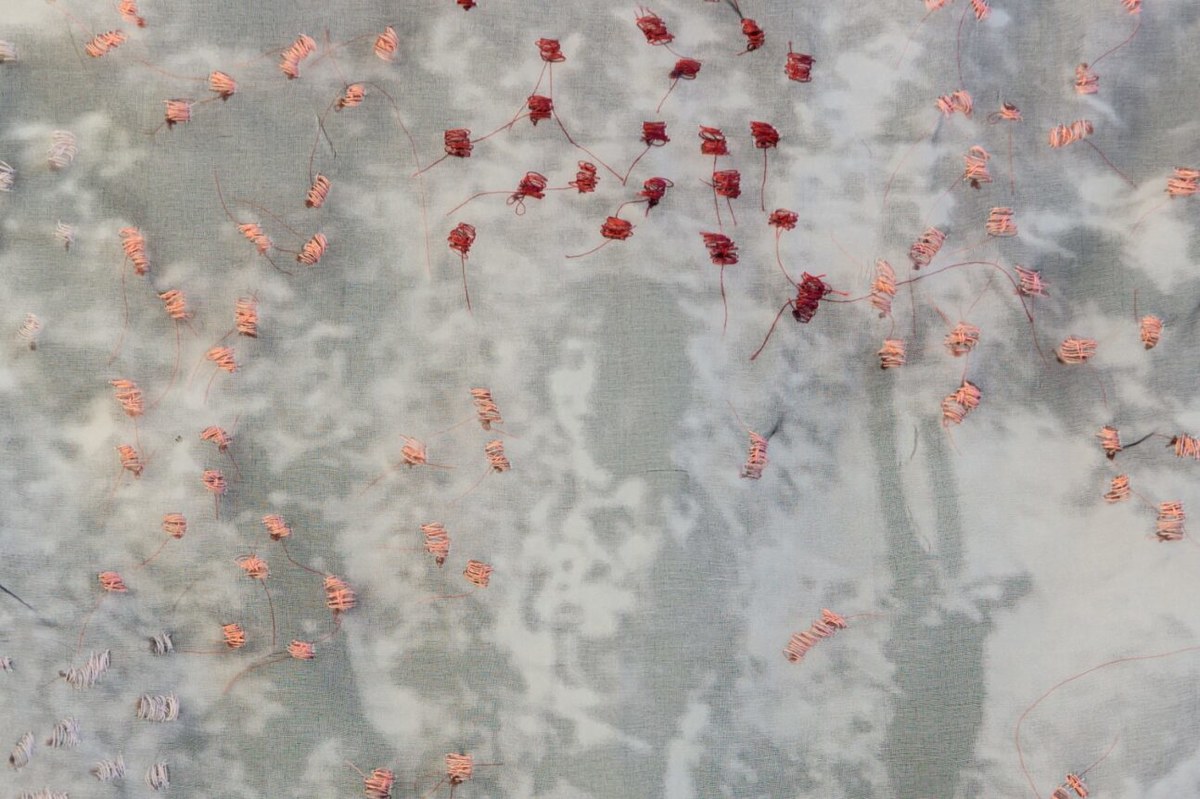
“It’s about me and my family history,” Almilli says of her work, which was most recently on display at Art Dubai in March. “It does really focus on heritage, history, personal narratives.
“Being from all these different identities, it’s always been important to be a part of those cultures,” she continues. “They’re all very different. And sitting with each and every grandparent, which I’ve had the privilege of doing, you learn so much. Growing up I’d have Turkish lullabies from my Turkish grandma, Kurdish news on the televsion that my grandpa would translate. My memory’s not great, but those specific moments from my childhood still remain; I still write about them and I’m still inspired by them. And I still want to almost recreate them in my work.”
Aside from her family history, the other major theme running through Almilli’s work is alienation or estrangement (as made clear in the title of her ongoing series “The Echoes of My Alienation”). That may seem odd in someone who talks so warmly of her close and nurturing family ties, but those same ties could, perhaps, have been one of the causes of her alienation.
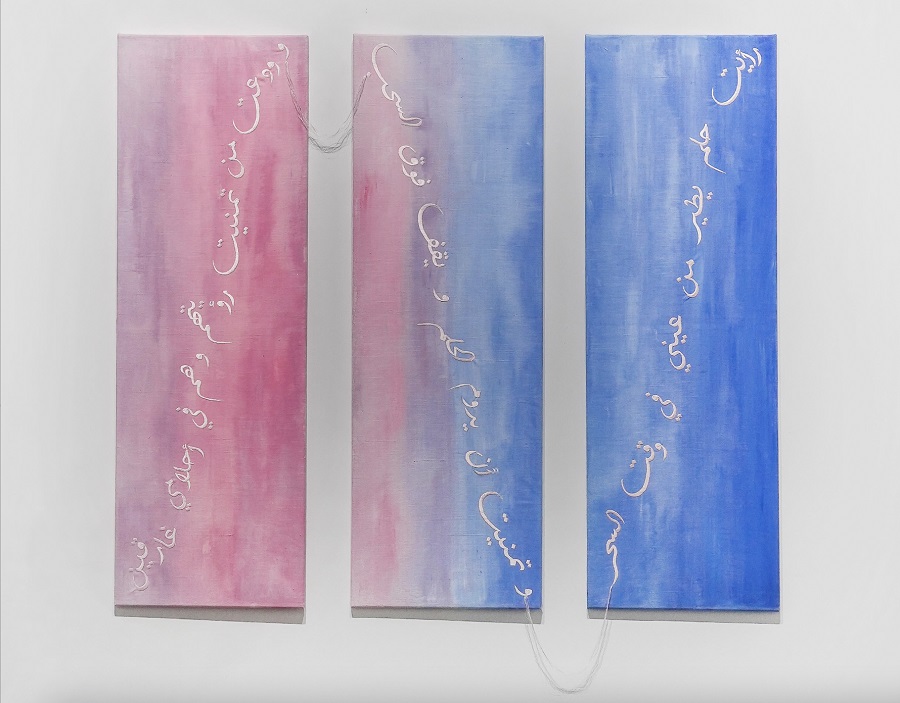
It really began when she moved to the US to attend the California College of the Arts in 2014. Initially, she was studying architecture, but, “I just hated it. I couldn’t express myself in any way that I wanted to.” She shifted courses, eventually graduating with a focus on textiles and creative writing, the latter allowing her to build on her poetry writing, which began as a teenager with verses that were “hidden under the bed — ‘No one’s looking at this.’”
It was towards the end of her college years that she began “The Echoes of My Alienation,” although the emotions it explores had surfaced almost as soon as she arrived in the States.
“My first day in the US, there was an earthquake, and I’d never experienced an earthquake. So it was almost like the beginning of this trial of alienation,” Almilli says. “I was, like, ‘I don’t know if this is for me.’ So persevering, and staying there for five years, was an interesting experience. It grew that alienation. And I wouldn’t say it has dissipated. It still stays, because if it doesn’t then that curiosity about finding out where I come from is gone.”
The series features a number of different works, including several self-portraits and images of family members embellished with embroidery.
“You can see the pieces are obsessively embroidered with little maps. I was almost mapping myself out — those identities that have always been a part of my life but that, to some extent, I had lost as I travelled to the US and was far from home. My grandma had Alzheimer’s at the time, too, so that history was lost with her. My grandpa had passed away in the first year I was in the US as well, so there’s this aspect of rediscovering and recreating history through myself in self-portraits.”
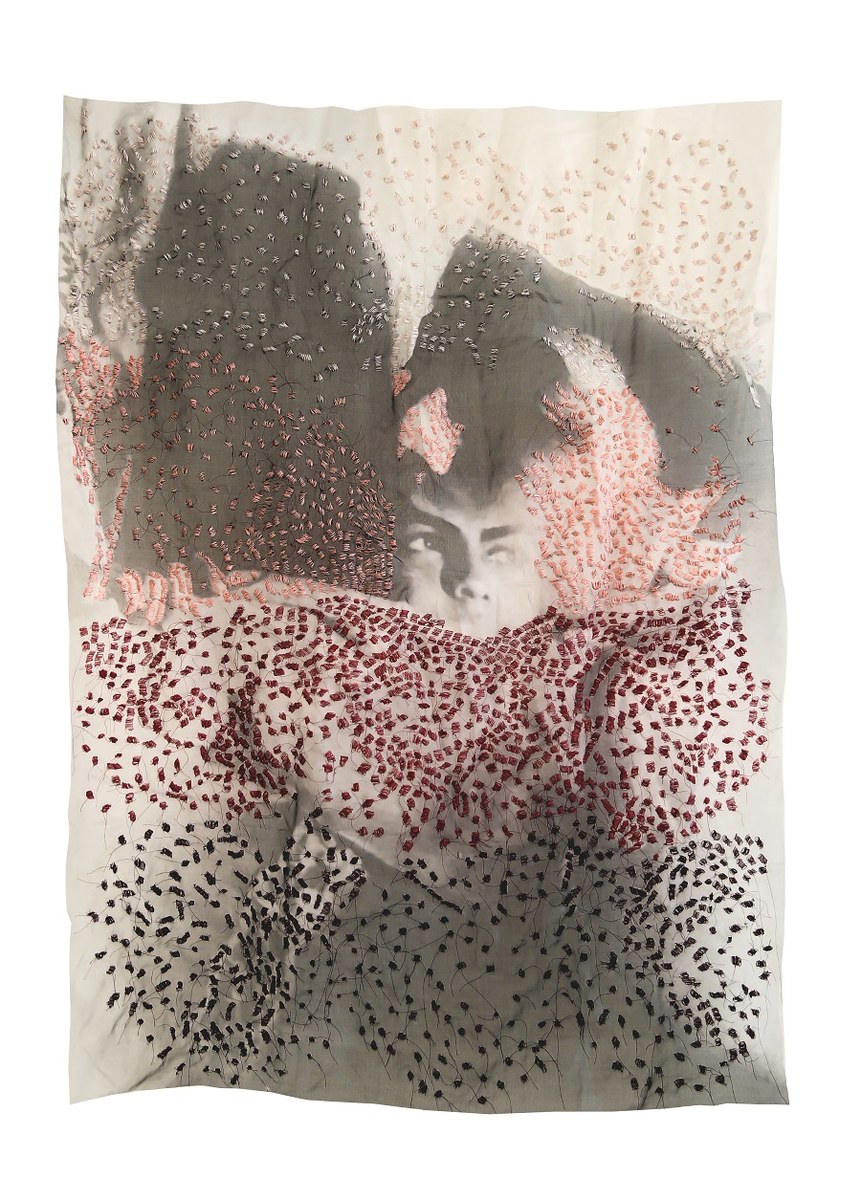
The “most emotional” section of the series, she says, is “Memoirs.” In “Memoirs 2” Almilli has embroidered delicate jasmine flowers over an image of her maternal grandmother in Syria, standing among trees.
“It’s the same technique I use every time, but I intuitively highlight specific parts of an image, whether it’s to hide or accentuate,” Almilli explains. “My grandma and I have a great connection with flowers.”
As she explored working with textiles, Almilli also developed her poetry skills. She has even published the poems that she once hid under her bed.
“At art school, you don’t really have that fear of exposing yourself, because everyone is. So I found the courage to take part in this school publication that went around California as well. That really re-started everything in terms of writing and, ever since, every piece I make has been inspired by a written poem.
“Usually, my works are unique pieces representing a story, or a dream, or someone,” she continues. “It’s interesting, because nowadays, with contemporary art, you’re meant to look at it and make your own sense of it. But, to me, it’s important to know the story of what happened. Being able to write, as an artist, is very important for me because it gives context to my work — what it represents, what it feels like.” She cites her piece on display at the Saudi Arabia Museum of Contemporary Art — “A fragile dawn, a floating wish, a fleeting farewell.” “That was initially a long poem that got turned into an embroidered piece that has the poetry within it,” she explains.
With so many different outlets for her creativity, her mind must be constantly churning with ideas, which seems like it could get exhausting, I suggest. But Almilli, who returned to Saudi Arabia in 2019, explains that she’ll often take a lengthy break after finishing a piece or a series.
“After each piece, there’s some sort of conclusion,” she says. “For example, the piece I just spoke about talks about how, in my dreams, I meet people I’ve loved, but they’re forever drowning in my dreams. Like, my grandma had Alzheimer’s for a few years and we couldn’t get her to Saudi. It’s almost like the only connection I had with her was when she showed up in my dreams. And to be able to write that and grasp it, and put it into something that is physical… it’s very difficult, in the beginning, because you’re facing the idea of that loss in the future, but after that comes a conclusion of sorts: ‘Now I understand these emotions.’ I try to think about what I wrote when I’m making each piece, and — if it’s a difficult piece — to try and heal from it in the process. That difficult feeling becomes something you can bear, whatever it might be.”
And even though her pieces are so personal, Almilli has found her work connects with people on a very emotional level.
“As much as my stories are about my personal history, and my family’s oral history and heritage, at the end of the day there are a lot of people that feel an alienation, or a craving after the loss of a person for that person. So they are stories that people can relate to,” she says.
“I cherish my pieces so much. It’s very difficult for me to let go of them, but I’ve grown to understand that it’s really about being able to share that story with people and show them that there are others going through that,” she continues. “It’s beautiful too, because I hear stories from others that they’ve never spoken about. It’s important, because it shows them that you can embrace multiple aspects of yourself, and that’s OK.”



